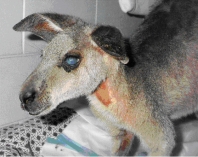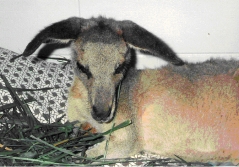Photosensitivty
During the years of integrating large mobs of Eastern Grey Kangaroos in readiness for release, we experienced a most unfortunate disease, which attributed to the death of 4 of 5 very healthy kangaroos.
We are forever learning by losses, and it's only at these times when we hit all the literature, that we realise how so many things can have a bearing on the nutrition of animals. We read where if the soil is deficient in certain minerals, e.g. cobalt, copper, iron, magnesium, manganese, zinc, etc., or the foods fed are deficient in elements, e.g. calcium, phosphorous, sulphur, vitamins, sodium, nicotinic acid, pantothenic acid, selenium, etc., these deficiencies can be attributed to disease.
And even the reverse can cause disease, too much of any of the above, or an imbalance between some of the above,.....it's a wonder we don't have more fatalities!
SYMPTOMS
The first signs displayed by a female kangaroo was drooping of the ears, and much head shaking, as though she had something in her ears, then her ears started to lose their fur and become shiny. She was forever scratching at her ears, which would give the impression that insects were bothering her, but this was not the case, and there were no parasites inside the ears.
Eventually the skin on the ears became very dry, necrotic, and pieces of dead skin began to fall off, leaving abrased skin which oozed a plasma like substance. Her ears swelled to twice their normal thickness, and hung down the sides of her head. The next sign was an opalisation (a blue film over all or part) of the eyes. It would appear only across the bottom of the eyes at first, and then eventually cover the whole eye.
She couldn't bear being in the sun and during the day, hid in the shed. At the time we were at a loss as to what was wrong, so were advised to treat with cortisone injections.
The injections did not change the situation and she proceeded to display more clinical signs. Her hands, hocks, feet and face began to swell and she began to lose weight rapidly.
Within a month, another roo displayed the same symptoms and although we tried everything in our power to save him, he also succumbed to this mystery disease.
Treatments tried included; intravenous fluids, antibiotics, cortisone, and antihistamines all to no avail.
VERIFICATION OF DISEASE
After losing two kangaroos, pathology tests verified that the disease was Photosensitivity.
Unfortunately, to throw us off the track with what the actual cause was of the photosensitivity, one of our females received an injury to her foot. We were dressing her injury every day and applying ORBENIN ointment, which had been advised by our veterinarian.
She began getting droopy ears and a slight opalisation of the eyes. By this stage we were almost tearing our hair out and decided to ring Dr. Rick Speare, the macropod specialist in Townsville. To our amazement, Rick told us that they had recently discovered that an ingredient in this particular ointment was connected with liver damage in human studies, so we decided to discontinue its use. He also suggested trying vitamin B injections. We gave her an injection of Vitamin B every second day, and within the week, all signs of the disease had gone.
CASE NUMBER THREE
By the time the next case occurred, we knew we were dealing with photosensitivity, so rather optimistically we began the vitamin B injections.
Unfortunately, as an ointment did not cause this case, the Vitamin B injections did not save him.
Although we tried many treatments over the next year or so, two more animals succumbed to this disease. They either died or were humanely put to sleep once it was obvious that liver damage had occurred. This was diagnosed by the jaundice, which was evident, by the yellow colour of their mucous membranes.
It was back to the drawing board to find the cause of the photosensitivity. We had eliminated the Lantana plants, prickle plants, and the food we were feeding them, there was only one thing left.........the Signal grass. After many phone calls to DPI, graziers, grass seed outlets etc., it was decided that it had to be the signal grass. Although DPI inspectors had long suspected Signal grass being a cause, they never really obtained the proof they required to state specifically that it caused photosensitivity.
It could well have been a fungus actually growing under the right conditions in the thick undergrowth which Signal grass provides, but whether it was a fungus, or the actual make-up of the grass, we were determined not to lose any more of our animals.
CAUSES OF PHOTOSENSITIVITY
This very nasty disease causes liver damage that in turn materializes many other symptoms.
The cause of photosensitivity is wide and varied, ranging from certain types of grasses, fungus attached to the grasses, right down to the actual lushness of the grass, and even certain drugs related to liver damage. Almost every type of grass is capable of causing photosensitivity. Certain noxious weeds and plants such as lantana are also attributed to the disease. Even improved pastures to top-dressed native pastures can cause photosensitivity. It is a case of elimination to determine which plant is actually causing the problem. Even the physical nature of the plant, and the amount of bleaching which occurs in the plant, plays a part in determining whether a particular ration of green pasture will photo-sensitise or not.
HOW PHOTOSENSITIVITY AFFECTS ANIMALS
Photosensitization comprises of a wide variety of disease conditions, all of which attributes to the skin's sensitivity to certain rays of the sun. In mild cases, some animals are able to overcome the condition by effectively excreting the toxins. If the animal is kept out of the sun, and excluded from the suspect pasture, there is sometimes a chance for it to overcome the disease. Unfortunately, we found this not to be the case with our kangaroos.
LESSON TO BE LEARNED
Our process of elimination included spelling our paddocks, which had various grasses and weeds growing in them. Each paddock was in between 3 and 5 acres, so eliminating each and every type of plant was very time consuming.
WHY WERE WE SO IGNORANT?
We chose to plant Signal Grass because it was a hardy grass that survived during drought and we were told that the wallabies loved it.
Our first mistake was believing a person who knew very little about macropods and our second mistake was planting only Signal grass in one of the paddocks, rather than allowing the animals a choice of various grasses.
Since we did not lose any of our many wallaby species to the disease, it was evident that the Grey Kangaroos were most susceptible, being more selective grazers.
Our process of elimination coincided with the fact that the roos that succumbed to the disease only did so after grazing in the paddock that had been planted solely with Signal grass.
When an animal has no choice, they are obviously going to eat whatever is available, even if it isn't palatable. The particular paddock which was situated on a small hill was seeded and transformed from a bare dusty hill, to a thick green paddock, and we felt good that we had provided such a beautiful mountain of grass for the 'roos. The second mountain had only a little Signal grass in it, and we had cleared the Lantana out of it. It was the best paddock, as it had a variety of natural grasses, Guinea grass and the small amount of Signal grass. After suspecting the Signal grass, we noticed that when the animals were in the paddock that had the variety of grasses in it, they tended to leave the Signal grass until last, so it must have been unpalatable for them. THEY knew not to eat it but WE didn't give them the choice when they were enclosed in the Signal grass paddock.
The terrible outcome of trying to do the best by our 'roos, resulted in our beautiful healthy animals succumbing to this.

And to make us feel even worse, the rotten Signal grass that caused the disease, is what we have placed in front of him to eat!

Back to top









